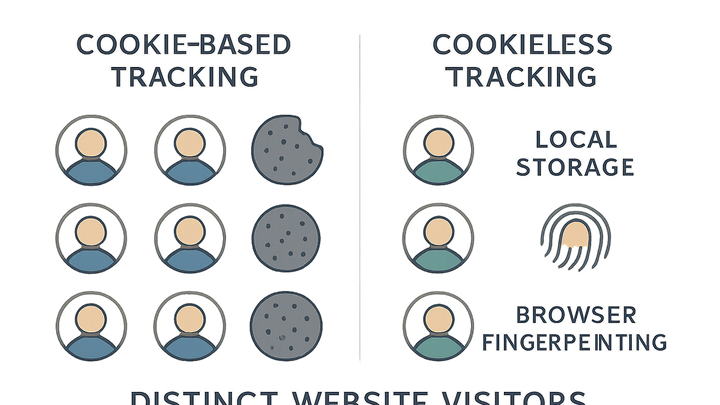Published on 2025-06-26T05:18:36Z
What is a Unique User? Examples for Analytics
Unique User is a metric in web analytics representing the number of distinct individuals who interact with a website over a specified period. Unlike total visits or pageviews, which count every session or page load, the Unique User metric ensures that each person is counted only once regardless of how many times they return. This measure is crucial for understanding the true size of an audience and for making data-driven decisions in marketing, product development, and user experience optimization. Different tracking methods—including cookie-based identifiers, login-based User IDs, and cookieless techniques—can influence the accuracy of unique user counts. While cookie-based methods are widespread (e.g., GA4’s first-party cookies), privacy-focused tools like PlainSignal employ local storage and browser fingerprinting to track users without cookies. Accurate unique user measurement helps businesses gauge reach, segment audiences, and allocate resources effectively.
Unique user
The count of distinct individuals visiting a website during a period, tracked via cookies, local storage, or cookieless methods.
Why Unique Users Matter
The Unique User metric reveals how many distinct individuals interact with your site or app, forming the foundation for audience analysis. Whether you want to measure marketing campaign impact, compare growth over time, or optimize user experience, understanding unique user counts is essential.
-
Audience reach
Shows the total size of your user base over a period, enabling you to understand how many people you are actually reaching.
-
Growth trends
By tracking unique users over time, you can identify growth patterns, seasonality, and the effects of new features or campaigns.
-
Retention analysis
Analyzing returning unique users helps measure loyalty and inform strategies to improve user engagement and retention.
How Unique Users Are Tracked
Unique Users can be identified through various methods depending on the analytics platform and privacy considerations. Common approaches include cookies, persistent identifiers, and cookieless techniques.
-
Cookie-based tracking
Assigns a unique identifier in a browser cookie. When the user revisits, the cookie reads the ID to recognize them.
-
First-party cookies
Set by your own domain, these cookies are less likely to be blocked by browsers.
-
Third-party cookies
Set by external domains (often ad networks); increasingly restricted by browsers and regulations.
-
-
User id
Logged-in users can be assigned a consistent ID across sessions and devices, ensuring more reliable counts.
-
Cookieless tracking
Leverages browser fingerprinting or local storage to persist identifiers without reliance on cookies.
Challenges in Measuring Unique Users
Despite its usefulness, measuring unique users accurately can be difficult due to technical and privacy constraints.
-
Cookie deletion and expiration
Users can clear cookies or use incognito modes, leading platforms to treat them as new visitors.
-
Cross-device and cross-browser tracking
The same person using multiple devices or browsers appears as separate unique users unless a common ID is used.
-
Privacy regulations and browser restrictions
GDPR, CCPA, and browser policies like Intelligent Tracking Prevention limit cookie usage and fingerprinting.
Unique User Measurement in PlainSignal and GA4
PlainSignal and Google Analytics 4 (GA4) both track unique users but use different approaches. Below are code examples and explanations for each.
-
PlainSignal example
PlainSignal uses a cookieless approach combining local storage and browser fingerprinting to count distinct visitors. Implement it by adding this snippet to your HTML:
<link rel='preconnect' href='//eu.plainsignal.com/' crossorigin /> <script defer data-do='yourwebsitedomain.com' data-id='0GQV1xmtzQQ' data-api='//eu.plainsignal.com' src='//cdn.plainsignal.com/plainsignal-min.js'></script>-
Local storage
PlainSignal stores a persistent identifier in localStorage instead of cookies.
-
Fingerprinting
It creates a device fingerprint to recognize returning visitors even if storage is cleared.
-
-
GA4 example
GA4 typically uses first-party cookies and Google Signals to identify unique users. Add this snippet to your site:
<!-- GA4 gtag.js snippet --> <script async src='https://www.googletagmanager.com/gtag/js?id=G-XXXXXXXXXX'></script> <script> window.dataLayer = window.dataLayer || []; function gtag(){dataLayer.push(arguments);} gtag('js', new Date()); gtag('config', 'G-XXXXXXXXXX'); </script>-
GA4 cookies
GA4 sets
_gaand_ga_<container-id>cookies to distinguish users. -
User_id parameter
Optionally, you can send a logged-in user’s ID with
gtag('config')to unify sessions across devices.
-
Best Practices for Accurate Unique User Tracking
To improve the reliability of unique user metrics, consider the following guidelines.
-
Implement a user id system
Encourage users to log in and pass a consistent User ID to your analytics to unify sessions.
-
Use server-side tracking
Server-side data collection can reduce data loss from ad blockers and provide more control over identifiers.
-
Combine multiple methods
Merge cookie, User ID, and cookieless approaches to improve coverage and reduce fragmentation.
-
Maintain privacy compliance
Respect user consent and data protection laws when implementing tracking solutions.
